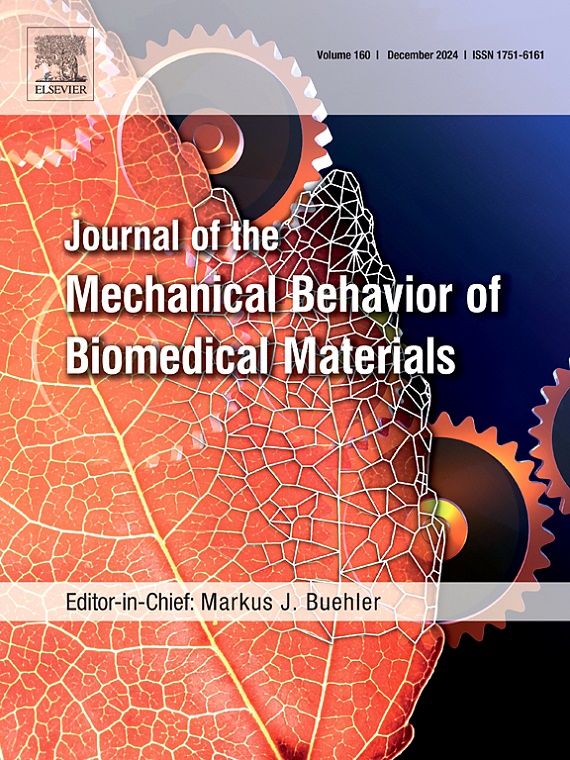Measurement of changes in muscle viscoelasticity during static stretching using stress-relaxation data
IF 3.5
2区 医学
Q2 ENGINEERING, BIOMEDICAL
Journal of the Mechanical Behavior of Biomedical Materials
Pub Date : 2025-07-05
DOI:10.1016/j.jmbbm.2025.107111
引用次数: 0
Abstract
This study investigates how muscle viscoelasticity changes during static stretching by measuring the state of the muscle during stretching using continuous time-series data. We used a device that applied a force to the muscle during stretching and measured the reaction force. The device was attached to each participant, and time-series data of the reaction force (stress-relaxation data) during stretching were obtained. The spring-pot model, which uses fractional calculus, was selected as the viscoelastic model for the muscle, to which the stress relaxation data were fitted on a straight line on a double-logarithmic plot. The stress-relaxation data formed a broken line comprising two segments on the double-logarithmic plot, showing that viscoelasticity changed abruptly at a particular time during static stretching. Considering two viscoelastic states, before and after the change, the stress-relaxation curve was fitted through segmented regression to the double-logarithmic data with high accuracy (R2 = 0.99 and NRSME = 0.0018). We compared the parameters of the spring-pot model before and after the change in muscle viscoelasticity. By examining these continuous time-series data, we also investigated the time taken for the effects of stretching to become apparent. Furthermore, we measured the changes in muscle viscoelasticity during static stretching before and after a short-term exercise load of running on a treadmill.
使用应力松弛数据测量静态拉伸过程中肌肉粘弹性的变化
本研究通过使用连续时间序列数据测量拉伸过程中肌肉的状态来研究静态拉伸过程中肌肉粘弹性的变化。我们使用一种装置,在拉伸过程中对肌肉施加一个力,并测量反作用力。将该装置连接到每个参与者身上,获得拉伸过程中反作用力(应力松弛数据)的时间序列数据。采用分数阶微积分的弹簧罐模型作为肌肉的粘弹性模型,将应力松弛数据在双对数曲线上拟合成直线。应力松弛数据在双对数图上形成一条由两段组成的折线,表明在静态拉伸的特定时间粘弹性发生突变。考虑两种粘弹性状态,对变化前后的双对数数据进行分段回归拟合应力松弛曲线,精度较高(R2 = 0.99, NRSME = 0.0018)。我们比较了肌肉粘弹性变化前后的弹簧-锅模型参数。通过检查这些连续时间序列数据,我们还研究了拉伸效果变得明显所需的时间。此外,我们还测量了在跑步机上进行短期运动负荷前后静态拉伸时肌肉粘弹性的变化。
本文章由计算机程序翻译,如有差异,请以英文原文为准。
求助全文
约1分钟内获得全文
求助全文
来源期刊

Journal of the Mechanical Behavior of Biomedical Materials
工程技术-材料科学:生物材料
CiteScore
7.20
自引率
7.70%
发文量
505
审稿时长
46 days
期刊介绍:
The Journal of the Mechanical Behavior of Biomedical Materials is concerned with the mechanical deformation, damage and failure under applied forces, of biological material (at the tissue, cellular and molecular levels) and of biomaterials, i.e. those materials which are designed to mimic or replace biological materials.
The primary focus of the journal is the synthesis of materials science, biology, and medical and dental science. Reports of fundamental scientific investigations are welcome, as are articles concerned with the practical application of materials in medical devices. Both experimental and theoretical work is of interest; theoretical papers will normally include comparison of predictions with experimental data, though we recognize that this may not always be appropriate. The journal also publishes technical notes concerned with emerging experimental or theoretical techniques, letters to the editor and, by invitation, review articles and papers describing existing techniques for the benefit of an interdisciplinary readership.
 求助内容:
求助内容: 应助结果提醒方式:
应助结果提醒方式:


